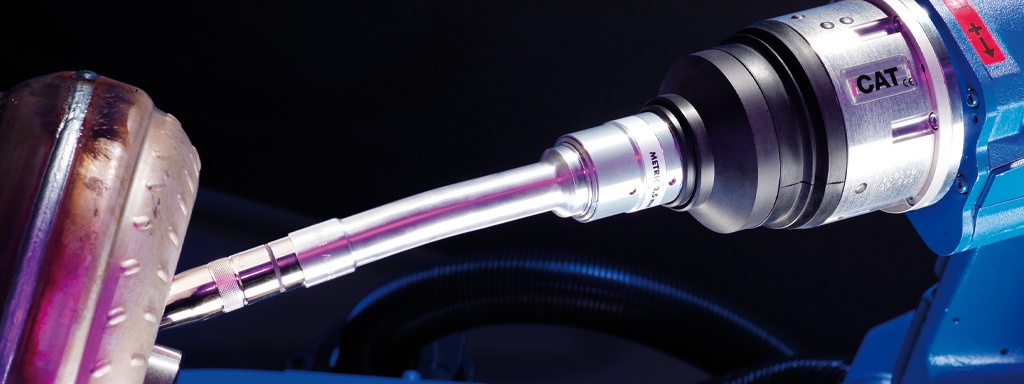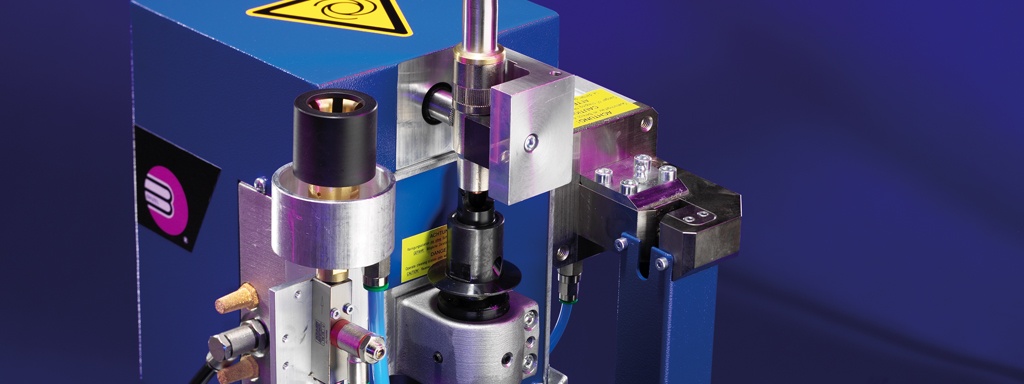Have you ever wondered how you can optimize the quality of weld seams in series production? Are you annoyed by rejects or rework? If you use welding robots including laser triangulation in your production, for example, you know that precise welds are essential – not only for stability, but also for the efficiency and cost-effectiveness of your processes. There are different sensors available and the question is: how many lines are better for your application? A sensor with one or three lines?
Laser triangulation in welding: How many lines does a sensor really need?
Topics: Robotic Welding, Seam Tracking
When welding tolerances become a trip to hell
Poorly prefabricated components, problems with correct clamping, material distortion due to heat from the process ... very often it is a major challenge to meet the required position tolerances during welding. Does this sound familiar to you?
Topics: Robotic Welding
Cobot vs. Robot – automation in welding
The question is no longer whether automation makes sense in the industry, but rather which type of automation is a better fit for welding – cobots or robots? While both technologies are capable of automating the welding process and thus increasing productivity, there are specific advantages and disadvantages that need to be considered when making a decision. In this blog post, we will look at the differences between cobots and robots in welding, highlighting factors to consider for effective automation of the welding process.
Topics: Robotic Welding, Automation
Optimising the service life of welding robots
In the two previous blogs on how to reduce downtime with welding robots, the focus was on the robot torch and its wear parts.
Topics: Robotic Welding
Downtimes due to wear parts during robot welding
In our first blog on how to reduce downtimes with robotic welding equipment, the focus was on robotic torches. We looked at the right choice of robot welding torch, torch power, torch geometry and highlighted that without “clean”' programming none of this will work.
Topics: Robotic Welding
How to avoid or reduce downtimes with welding robots
When it comes to high quantities, cost and time pressure, welding robots provide valuable assistance. With them, consistent quality can be achieved in the shortest possible time. However, productivity in automation or robotics also depends significantly on how often and how long a welding robot is at a standstill because it has to be reloaded, set up again after a crash or generally maintained. Every second of downtime counts and costs money. And it cannot be generalised who is more affected by downtimes in production: the group with large robot production lines or the small medium-sized company that only has one welding robot in operation. A welding robot in industry must function trouble-free as much as possible – and having the right equipment in production or in the company helps with this. Find out here how to reduce downtimes for welding robots.
Topics: Robotic Welding
Fume extraction for robotic welding – nice-to-have or must-have?
The fact that the welder is close to the welding process and would therefore be completely exposed to the dangerous gases in the welding fumes without a fume extraction system is no surprise. But how is the situation when using a robot for welding? Do similar precautions need to be implemented as with manual welding? Just as with manual welding, the dangers of welding fumes should not be underestimated.
Topics: Robotic Welding, Fume Extraction
Aluminum welding with a cobot – does that work?
7 practical tips for a neat weld seam
No question: aluminum welding is the premier class of welding. In a previous blog we explained in detail what a manufacturing company should pay attention to when welding aluminum by hand. But what do you do when the quantities are so high that one welder alone can no longer handle them? If hiring an additional welder for aluminum welding is not an option or you simply cannot find a suitable welding specialist? Can you possibly also weld aluminum in industry with a cobot – i. e. a collaborative robot – or is it too difficult to program a cobot to achieve the same results as when welding aluminum manually.
Topics: Robotic Welding
4 Things to Consider Before Automating TIG Welding
Is automated TIG welding economically viable?
When automating a TIG application, the first question to ask is the same as for any other automation: Is it profitable to use a robotic welding torch or a robotic welding cell?
Topics: Robotic Welding, TIG Torches
Welding with a robot – the 5 most common mistakes
The welding robot has been programmed for hours. The straight paths work perfectly, when welding a curve everything is wrong back and forth – what happened? The industrial robot is synchronized, the component is fastened and the weld seam is still set incorrectly – where is the mistake? On the first day, tens of components were perfectly welded, the next day the seam was displaced – how could that happen?
Topics: Robotic Welding
5 reasons for welding with a cobot
It doesn’t have to be a welding robot!
At some point, the time has come and:
- the manual welder reaches the limits of his physical capacity
- the quantities are too large to meet the desired delivery date
- the topic of automation must be discussed
Automation? Aren’t these robot welding cells which usually take up a lot of space and are really expensive? In order to make their purchase profitable, enough parts have to be processed to operate the system at full capacity. In addition, there is the programming of the welding robot, which requires additional knowledge. Is there no interim solution if an industrial welding robot is still a size too big? Yes, there is: cobot welding.
Topics: Robotic Welding
Automated welding: How to minimize welding errors
The beam on the workshop floor seems endless. The back hurts already at the mere thought of having to weld in the same position for the next few hours. Take up position, put on, weld off, put down, slide forward. Unfortunately, it is unavoidable that over time the welding seam is not as good as it was at the beginning. Or maybe it can? Automated welding provides a remedy ... for poor weld seam quality of long, repetitive welding tasks, for welding errors, but also for monotonous and painful joints.
Topics: Robotic Welding
Don’t be afraid of automation when welding!
Why cobot welding can be the solution for small and medium-sized companies
Automatically working welding robots as far as the eye can see. The robot arms move sometimes hectically, sometimes silently. There is a hiss, hum, and crackle in the air. You can only recognize a person here and there. Automation clearly dominates. Such a vision is more of a fear image for small and medium-sized companies, because people here seem to be completely in the background, yes, being pushed out of their job. So it seems. A machine like a collaborative robot – a so-called cobot – can support people in their work. The use of cobots in welding can thus become an economical solution for small and medium-sized companies.
Topics: Robotic Welding
iCAT W Tool Bar Settings: A Quick Guide
This quick guide will show you the correct way to install a water/liquid cooled harness using the iCAT setting bar (part number 980.2153).
Topics: Robotic Welding
iCAT A Tool Bar Settings: A Quick Guide
This quick guide will show you the correct way to install an air/gas cooled harness using the iCAT setting bar (part number 980.2153).
Topics: Robotic Welding
How to Fit iCAT to a Lincoln Wire Feed Unit
This quick guide will show you the correct way to install an iCAT harness to a Lincoln Wire Feed Unit to eliminate premature failing of the harness.
Topics: Robotic Welding
TMS-VI Troubleshooting Guide for Your Torch Cleaning Station
PLEASE NOTE:
Topics: Robotic Welding
Weekly Maintenance on a TMS-VI Front Injector for Cleaning Stations
The front injector TMS-VI is nearly service-free.
However, it is important to carry out regular cleaning and inspection of the mechanical parts to make sure the equipment is fully functional and has a long life cycle. For correct setup procedure, see the manual provided with each unit.
Topics: Robotic Welding

/Blog/Laser_triangulation_in_welding_How_many_lines_does_a_sensor_really_need/Laser_triangulation_how_many_lines_sensor_banner.png)

/Blog/When%20welding%20tolerances%20become%20a%20trip%20to%20hell/Banner_Welding_tolerances_1.webp)
/Blog/Cobot%20vs.%20Robot/AdobeStock_524333381_automation_800_300.jpg)
/Blog/Stillstandzeiten/3/Teaser_Blog_3_800x300.jpg)
/Blog/Stillstandzeiten/2/Teaser_Blog2_EN.jpg)
/Blog/Stillstandzeiten/1/Teaserbild_Blog_Stillstand_800x300px.jpg)
/Blog/Fume%20extraction%20for%20robotic%20welding%20%E2%80%93%20nice-to-have%20or%20must-have/fume_production.jpg)
/Blog/Aluminium%20welding%20with%20a%20Cobot/Cobot_Aluminium_Welding_2.jpg)
/Blog/Automated_TIG_Welding/ABITIG_MT_500W_KDZ_CAT2_Fanuc_LB_0064_oCAT2.jpg)
/Blog/Robotics/CAT3_PRO_TR_Action_800x300px.jpg)
/Demo%20Request%20iBOTone/iBOTone_cpl_color_1200x450_banner.jpeg)
/Blog/Automatisiertes%20Schwei%C3%9Fen%20-%20So%20minimieren%20Sie%20Schwei%C3%9Ffehler/SpoolWeldingRobot-NOVARC-weld-seam-control-on-screen_blog_banner.jpg)
/Demo%20Request%20iBOTone/iBOTone_Action_with_welder_1200x600_banner.jpeg)
/Blog%20Pictures/Nissan_iCAT_Tool_Bar_B.jpg)
/Blog%20Pictures/Nissan_iCAT_A_Tool_Bar_2.jpg)

